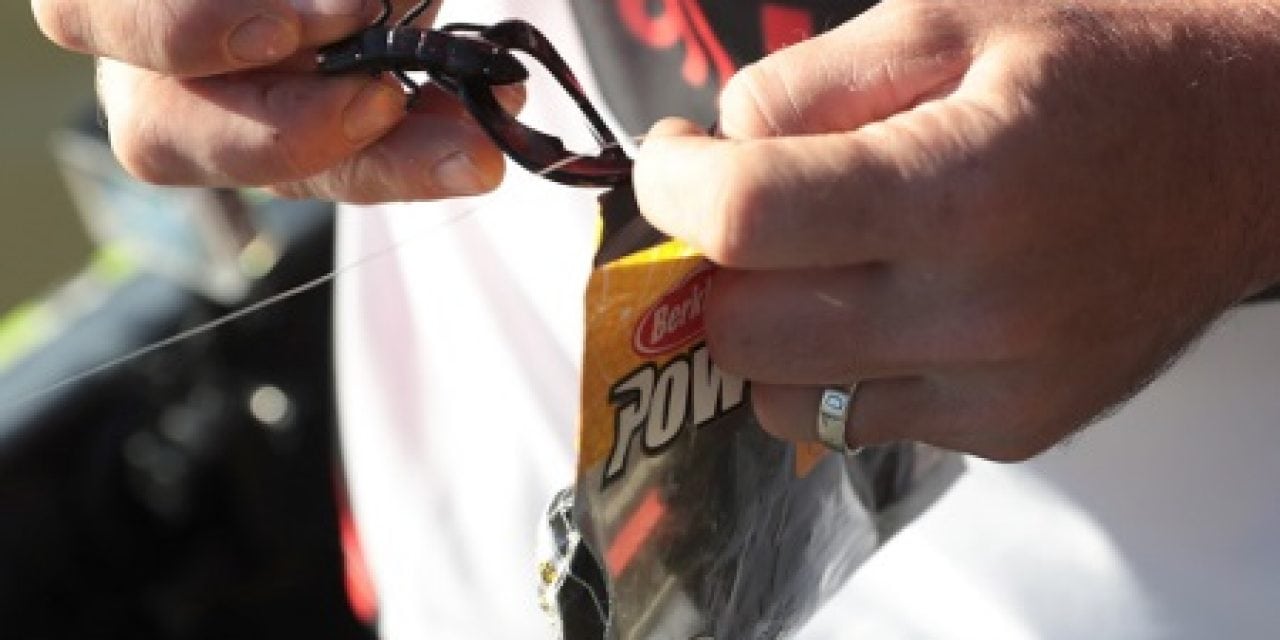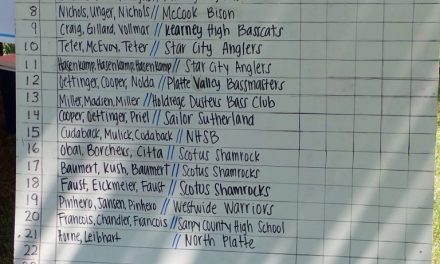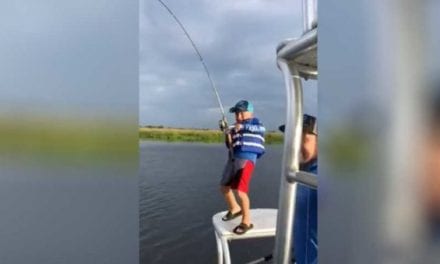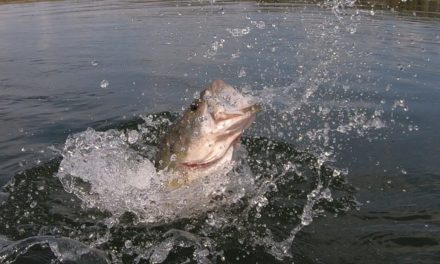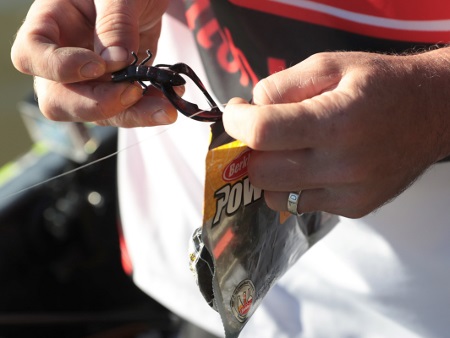 Berkley’s Josh Bertrand Reveals His Top Winter Bass Patterns. Many bass fans stash their tackle in cold storage during the winter, but Berkley pro Josh Bertrand isn’t one of them. The savvy Arizona angler knows the coldwater period offers ample opportunities to catch largemouths, spots and smallies. In fact, he says that firing up a school of burly winter bass can spark incredibly fast action.
Berkley’s Josh Bertrand Reveals His Top Winter Bass Patterns. Many bass fans stash their tackle in cold storage during the winter, but Berkley pro Josh Bertrand isn’t one of them. The savvy Arizona angler knows the coldwater period offers ample opportunities to catch largemouths, spots and smallies. In fact, he says that firing up a school of burly winter bass can spark incredibly fast action.
To tap the winter bite, Bertrand targets high-percentage areas with a handful of pet patterns. The strategies hold water on his home lakes in Arizona, but can also help you catch more bass this winter on lakes across the country.
Setting The Stage
Before we delve into tactics, let’s explore the world of the winter bass. “The fish aren’t thinking about spawning and they’re not very active,” Bertrand begins.
“They’re looking for a comfortable place to hang out that offers stable conditions and an opportunity to feed when they need to,” he continues. “Because bass metabolism slows way down in cool water, they might only require a meal once or twice a day. In really cool water, they may only feed once every couple of days.”
Bertrand says ideal winter bass habitat often includes deep water, either in the form of fertile flats or channel edges where bass can move up and down the breakline to feed.
“In the lakes I fish out West, deep creek channels and flats in 30 to 40 feet of water hold bass,” he explains. “In shallower systems elsewhere in the country, the fish might relate to the deepest bank, channel or other drop-off they can find.”
Regardless of the zip code, Bertrand says rocks or woody cover sweetens the structural pot. “Rocks hold food and heat,” he says. “And deep, flooded trees or brush can also be bass magnets.”
Baitfish are also a factor, he notes. “Bass are going to be where the bait is,” he says. “Shad are a common forage species in many lakes. Because they’re fragile and can’t handle cold water, they tend to favor these same types of areas. When the water is 44 degrees, you’re not going to find shad in two feet of water in a creek arm.”
Football Fever
Bertrand would much rather drag a football head for winter bass than watch football on TV, and says the deadly jigging approach is a time-tested means of putting coldwater bass in the boat.
“It’s definitely an old reliable tactic you can use just about anywhere you find bass,” he says.
To get started, he locates a bassy-looking area like the end of a steep rock bluff or channel swing, and reaches for a 7½-foot, medium-heavy casting outfit spooled with 15-pound-test Berkley Trilene 100 Percent Fluorocarbon.
He ties a ½- to ¾-ounce football-style jighead direct to the mainline, and threads a 4-inch, green pumpkin-pattern Berkley PowerBait Chigger Craw on the hook. “Football heads are great on rocky bottoms because they rock and roll over cracks and crevices, without falling in and snagging like other types of jigs,” he says. “A PowerBait trailer is key because its scent encourages bass to hang onto the bait long enough for me to feel the bite and make the hookset.”
Rigged and ready, Bertrand fires out a long cast and lets the jig fall to bottom on slack line, then begins a slow, crawling retrieve. “Use the rodtip to slowly move the jig an inch at a time,” he says. “If you think you might be going too slow—slow down a little more.”
Strikes are soft and often register merely as “mushy” feelings on the end of the line. “Hooksets are free and there’s no limit, so set the hook anytime you feel something different,” he advises.
Jerkbait Blitz
Slim-profile, hard-bodied jerkbaits also excel during the big chill. “They’re great search baits,” says Bertrand, who favors suspending models with a decent-sized profile, like the 4 3/8-inch Berkley Cutter 110+ in shades of Chartreuse Shad or Chameleon Vapor. “It gives bass a shot at a meal worth eating, yet can be suspended for extended periods to allow sluggish fish to swim over and take the bait.”
Bertrand explains that jerkbaits mimic the death throes of an expiring shad. “Dying shad hang motionless, twitch a little, pause and sink, then twitch again,” he says. “Fished in a twitch-pause-twitch cadence with a little slack in your line to foster erratic lure movement, jerkbaits imitate this performance perfectly.”
To replicate a shad’s grand finale, Bertrand wields a 6-foot, 4-inch, medium-action casting combo. He notes that graphite rod blanks spiced with strands of fiberglass create a limber, forgiving combination that helps keep lightly hooked bass from coming unbuttoned during battle.
He favors 10-pound Berkley Trilene 100 Percent Fluorocarbon in water temperatures of 50 degrees and higher. In cooler conditions, he opts for 10-pound Berkley Trilene XT monofilament. “Mono floats, so it won’t pull your jerkbait down, even during extremely slow retrieves,” he says. “I typically pause five seconds or less in 50 degree water, but may only twitch the bait every 10, 20 or even 30 seconds in colder water.”
Bertrand adds that hardbaits are currently riding a rising tide of popularity among winter bass anglers. “Suspending jerkbaits have been around for years, but more people are using them now,” he says. “And people are also starting to realize that crankbaits catch coldwater bass, too.”
In fact, he believes cranking a Berkley Pitbull or Berkley Bad Shad 7 is a great way to trigger tough-bite bass when nothing else will. “You’re still not smoking the bait super-fast,” he cautions. “But a medium to medium-slow retrieve can draw reaction strikes, even in the dead of winter.”
Spoon Savvy
Jigging spoons also work wonders for winter bass. “Look for bass tucked tight to bottom on your sonar, then fish a ½- to 1-ounce chrome-finish, slab-style jigging spoon in aggressive, two- to five-foot lifts,” he says, noting that catching the first bass in a school is often paramount to inciting a feeding frenzy.
“When you reel one in, the rest of the bass get all worked up because they just saw one of their buddies eat a pizza and now they want a slice, too,” he laughs.
Although, Bertrand doesn’t tip his spoons, anglers in northern regions where lakes freeze over often add the scent and flavor or a chunk of PowerBait or Gulp! softbait to the show.
In the Ice Belt, smaller, thinner spoons are deadly fished close to soft bottoms on flats where schools of juvenile panfish offer bass an easy meal. But that’s a story for another day. For now, use Bertrand’s open-water strategies to catch more bass all winter.
The post Berkley Fishing – Catch The Big Chill For Bass appeared first on ODU Magazine-North America's #1 Digital Fishing Magazine.

